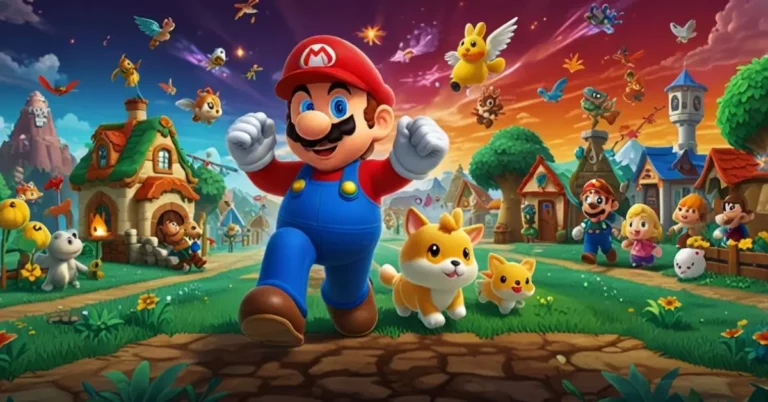Nintendo, a titan in the gaming industry, has significantly impacted the mobile gaming sector. Their journey into mobile gaming has been marked by innovation, experimentation, and strategic pivots, reflecting their commitment to adapting to the evolving gaming landscape.
The Genesis of Nintendo Mobile Gaming
Nintendo’s foray into mobile gaming began in 2016 with the release of Super Mario Run, marking a significant shift from their traditional console-centric approach. This move aimed to leverage the burgeoning mobile gaming market, which accounted for approximately 49% of the total gaming revenue in 2024.
Nintendo’s Mobile Game Portfolio
Over the years, Nintendo has developed and released several mobile games, each reflecting their iconic franchises and innovative gameplay mechanics.
Super Mario Run
As Nintendo’s inaugural mobile game, Super Mario Run introduced the beloved plumber to smartphones, offering a one-handed gameplay experience. Despite its initial success, the game’s premium pricing model faced criticism, leading Nintendo to explore alternative monetization strategies.
Fire Emblem Heroes
Launched in 2017, Fire Emblem Heroes embraced the free-to-play model with in-app purchases, achieving significant success and becoming one of Nintendo’s top-grossing mobile titles.
Animal Crossing: Pocket Camp
This game brought the charming life-simulation experience of Animal Crossing to mobile devices, allowing players to build and manage their campsites. Its casual gameplay and social features resonated with a broad audience.
Mario Kart Tour
Mario Kart Tour adapted the high-speed racing action of the console series to mobile platforms, incorporating real-world locations and a gacha system for character and vehicle unlocks.
Pikmin Bloom
Developed in collaboration with Niantic, Pikmin Bloom combines augmented reality with fitness tracking, encouraging players to explore their surroundings and plant virtual flowers.
Comparative Analysis of Nintendo Mobile Games
| Game Title | Release Year | Monetization Model | Notable Features |
|---|---|---|---|
| Super Mario Run | 2016 | Premium | One-handed gameplay, classic platforming |
| Fire Emblem Heroes | 2017 | Free-to-play | Gacha mechanics, strategic battles |
| Animal Crossing: Pocket Camp | 2017 | Free-to-play | Social simulation, customizable camps |
| Mario Kart Tour | 2019 | Free-to-play | Real-world tracks, gacha elements |
| Pikmin Bloom | 2021 | Free-to-play | AR integration, fitness tracking |
Strategic Shifts and Market Performance
Nintendo’s mobile gaming strategy has evolved over time, reflecting their adaptability and responsiveness to market trends. Initially hesitant, Nintendo embraced mobile gaming to expand their audience and revenue streams. By 2020, their mobile games had generated over $1 billion in revenue.
However, the company has also faced challenges, including the shutdown of Dragalia Lost in 2022 due to declining engagement. Despite these setbacks, Nintendo continues to explore mobile gaming opportunities, reaffirming their commitment to the platform.
Integration with the Broader Gaming Ecosystem
Nintendo’s mobile games serve not only as standalone experiences but also as gateways to their broader gaming ecosystem. By introducing players to their franchises on mobile devices, Nintendo encourages engagement with their console offerings, merchandise, and other media.
Conclusion
Nintendo’s journey in mobile gaming underscores their ability to innovate and adapt in a rapidly changing industry. Through strategic experimentation and leveraging their iconic franchises, Nintendo has carved a niche in the mobile gaming market, enhancing their overall gaming ecosystem.
FAQ’s
What was Nintendo’s first mobile game?
Nintendo’s first mobile game was Super Mario Run, released in 2016.
Which Nintendo mobile game has been the most financially successful?
Fire Emblem Heroes has been one of Nintendo’s top-grossing mobile games.
Has Nintendo discontinued any of its mobile games?
Yes, Dragalia Lost was discontinued in 2022 due to declining engagement.
How does Nintendo monetize its mobile games?
Nintendo employs various monetization models, including premium pricing and free-to-play with in-app purchases.
Are Nintendo’s mobile games connected to their console games?
While primarily standalone, some mobile games serve as introductions to Nintendo’s console franchises.
Is Nintendo planning to release more mobile games in the future?
Nintendo has reaffirmed its commitment to mobile gaming and continues to explore new opportunities in the space.

